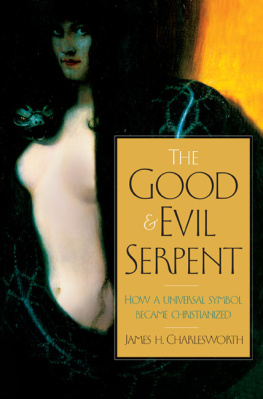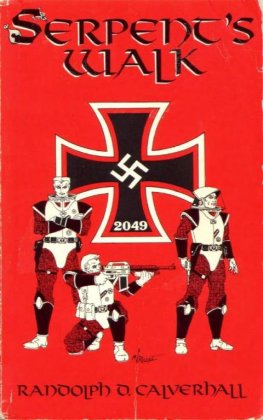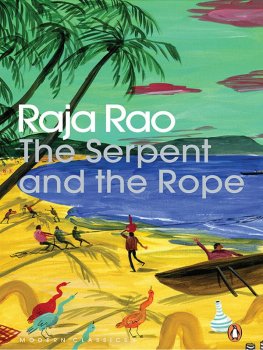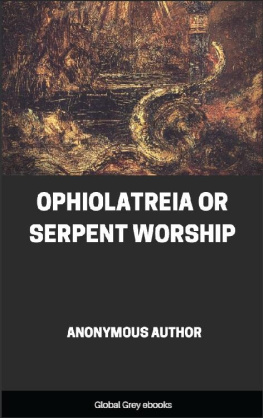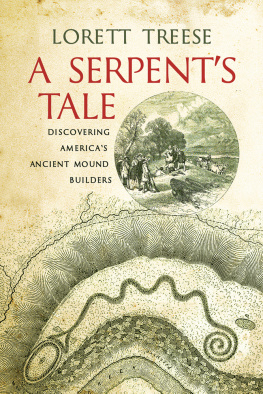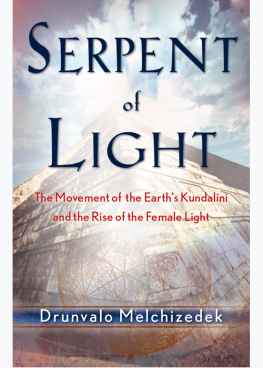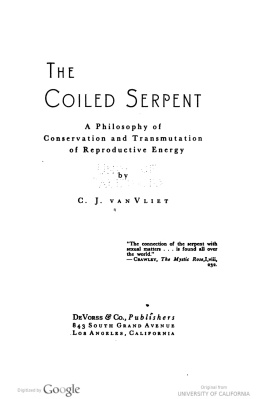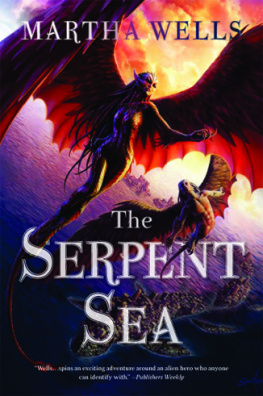THE GOOD AND
EVIL SERPENT
THE ANCHOR YALE BIBLE REFERENCE LIBRARY is a project of international and inter-faith scope in which Protestant, Catholic, and Jewish scholars from many countries contribute individual volumes. The project is not sponsored by any ecclesiastical organization and is not intended to reflect any particular theological doctrine.
The series is committed to producing volumes in the tradition established half a century ago by the founders of the Anchor Bible, William Foxwell Albright and David Noel Freedman. It aims to present the best comtemporary scholarship in a way that is accessible not only to scholars but also to the educated nonspecialist. It is committed to work of sound philological and historical scholarship, supplemented by insight from modern methods, such as sociological and literary criticism.
John J. Collins
GENERAL EDITOR
THE ANCHOR YALE BIBLE REFERENCE LIBRARY
THE GOOD AND
EVIL S ERPENT
How a Universal Symbol Became
Christianized
JAMES H. CHARLESWORTH

The Anchor Yale logo is a trademark of Yale University.
Copyright 2010 by James H. Charlesworth.
All rights reserved.
This book may not be reproduced, in whole or in part, including illustrations, in any form (beyond that copying permitted by Sections 107 and 108 of the U.S. Copyright Law and except by reviewers for the public press), without written permission from the publishers.
Designed by Leslie Phillips.
Set in Sabon type by dix!
Printed in the United States of America by Sheridan Books, Inc.
Library of Congress Cataloging-in-Publication Data
Charlesworth, James H.
The good and evil serpent : how a universal symbol became christianized / James H. Charlesworth.
p. cm.(The Anchor Yale Bible reference library)
Includes bibliographical references and index.
ISBN 978-0-300-14082-8 (alk. paper)
1. DevilChristianity. 2. Symbolism. 3. SnakesReligious aspectsChristianity. 4. Good and evil. 5. Good and evilReligious aspectsChristianity. I. Title.
BT982.C43 2009
220.64dc22 2008036207
A catalogue record for this book is available from the British Library.
This paper meets the requirements of ANSI/NISO Z39.48-1992 (Permanence of Paper).
10 9 8 7 6 5 4 3 2 1
For faithful vitrs and biblical colleagues
who have shared parts of two millennia with me:
Savas Agourides Jim Armstrong Peder and Inge Borgen
Frank Cross Archbishop Damianos Tom Gillespie
Martin and Mariana Hengel Doron and Michal Mendels
Pat Miller Petr and Vra Porkorn Jim Roberts
James Sanders Moody and Jane Smith
Walter Weaver Orval Wintermute
and those especially close who passed over:
Hugh and Jean Anderson
Pierre Benoit
Ray Brown
Roland de Vaux
Noel Freedman
John Priest
William Stinespring
indeed, all who helped me intermittently enjoy the wise serpents viticum
Preface
Writing this book has been a journey. I have been searching for spiritual insights. For six years of research, I have attempted to discover what the serpent may have symbolized for the ancients as they explored the perennial questions that define the human. During this period, I tried to keep in mind all who question boldly and freely. Since before attending seminary I have admired the great minds who with apparent Promethean arrogance focus on the Scriptures, boldly searching for the original meaning(s) of some perplexing passages. Thus, I am writing not so much for scholars, preachers, or rabbis as for those who are searching for answers in a culture shaped and influenced by the church and synagogue. I am writing for those who are no longer afraid of freely studying the books canonized as the Bible. Such free inquiry was often condemned in the past, especially after the Palestinian Jesus Movement became an institution. The leading thinkers in this organization, the church, had to fight for its survival against many powerful ideologies and mythologies. In the following pages, I will clarify how the Asclepius story threatened the Jesus Gospel.
Did the Fourth Evangelist inherit an ophidian Christology; that is, was the Evangelists conception of Jesus influenced by the symbolism of a serpent? Did this genius imagine Jesus in terms of the serpent symbolism that had developed for millennia prior to his masterpiece? Did he formulate his presentation of Jesus, whom he hailed as Gods Son and the Christ, in some way with images obtained from the mythology of the serpent?
I have found that the commentators on the Fourth Gospel have missed the full meaning of John 3:1316. It is evident that some of them were afraid to boldly and freely raise fresh questions. Far too many did not wrestle with the original meaning of this passage. Perhaps now, at the beginning of the third millennium, it is possible for all of us to think faithfully and creatively. Is that not the freedom Jesus shared with his earliest followers?
I see my task as a professor of New Testament at Princeton Theological Seminary rather simply. All of us who are interested in hearing the truth need to cleanse our ears of the disturbances in Western society. Then we may hear the authors who speak to us from the ancient canonical and extra-canonical texts. There is a vast amount to learn from those who lived long ago in the Near East. Some authors of biblical books and works contemporaneous with them were geniuses. Sometimes they understood aspects of life better than any of us today. This is especially clear when we examine carefully and afresh the thoughts and language of the authors of Genesis 3 and John 3.
If I can help some to appreciate the creativity of the biblical authors and to read the Bible free from dogmas that deafen our ears to eternal truths, then my joy in writing will be complete. I am not eager for all to agree with my attempt to understand the biblical texts, but I do urge all attracted by the Bible to attend personally to the words in our texts. The Scriptures are our main source for inspiration. As those in the synagogue and church have endeavored to teach, despite some of their administrators, the ancient writings contain echoes of the still small voice that resonates within our hearts.
Finally, it might be of interest to some readers to know why I have been attracted to this subject. Why would a scholar at Princeton spend six years studying the images and symbols of serpents? Rather than consider me nuts, virtually all who have heard about my forays into ancient folklore stop, listen, and then utter words like: Wow, that is fascinating.
What then is my answer to this question? I grew up on the eastern fringes of the Everglades. Rumors about dangerous snakes would circulate around Delray Beach, Coconut Grove, and Coral Gablesthe places in which I lived in the 1950s and 1960s. Some of these stories were about snakes finding their way into homes. There were reports of a woman entering the bathroom only to find a moccasin in the bathtub. I also recall the account of a woman who sat down on a toilet and looked down, between her legs, at a poisonous snake in the water below.
I heard about coral snakes and feared these small reptiles that hide threateningly under Palmetto palms. The attractively colored snakes have venom more deadly than cobras. My encounter with a gigantic serpent, however, was unusual. This frozen moment in time may have shaped my fascination with snakes far more than I may realize.
Thinking back to 1953, when I was thirteen, I remember a golden-domed figure rising before me. He was massive in size and weight. The creature reflected the sun that poured down on us from the right. I remember that his eyes were on the level of my own, and I was then roughly 5 feet, 5 inches (1.65 meters) tall. He swayed before me. I was simultaneously frightened and awestruck at this wonder of creation. He stood erect, and the sun transformed him into blinding gold. For years I dismissed from memory the height of this monster, and how time and eternity stopped as we looked deep into each others eyes. You, the reader, will think I have succumbed to mythology.
Next page
